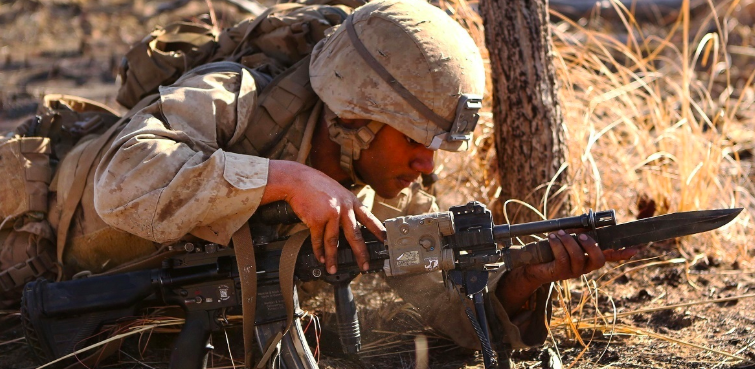Today’s military has many antiquated training plans still written into the calendar. Troops will still practice drill and ceremony despite the fact that the need for marching into combat died out more than a hundred years ago. We still sharpen our land navigation skills despite the fact that we have overwhelming technological advantages that make the use of more primitive tools highly improbable.
However, the one training that always draws the loudest “but why?” from the back of the formation is bayonet warfare. And you know what? That loud, obnoxious dude isn’t entirely wrong — the last time “fix bayonets!” was officially ordered to a company-sized element in combat was by Col. Lewis Millet during the Korean War.
But bayonet training isn’t about just learning to attach a “pointy thing to your boomstick and poking the blood out of people,” as an old infantry sergeant once told me. It’s about laying the fundamentals of everything else.
Bayonet training was officially taken off the Army’s basic training schedule back in 2010 because it created scheduling conflicts with other needed skills. Still, some drill sergeants find a way to work it in on their own time. The Marine Corps still learns the skill, but it’s a part of the greater Marine Corps Martial Arts Program.
The training is always conducted in stages. The first stage is to have the recruits train on pugil sticks — giant, cotton-swab-looking sticks. This teaches a warfighter the importance of maintaining a positive footing while trying to overpower an opponent. Literally anyone can take on anyone in a pugil stick match because it’s not about size or strength — it’s about control.
Learning to control your body while asserting dominance on your enemy is crucial in close-quarters combat. Once you’ve mastered the pugil stick, you can move on to bayonets.
It’s only silly if you make it silly. If you do, the other guy will knock the silliness out of you.
(U.S. Marine Corps photo by Staff Sgt. Melissa Marnell)
Fighting with a bayonet is less like fighting with a rifle that happens to have a knife attached and more like using a spear that has a rifle on it. Much of the same footwork learned while training with pugil sticks plays a role here. Maintain good footing, thrust your bayonet into the enemy, and send them to their maker.
Maintaining good footing is a fundamental of nearly every single martial arts form known to man. Instead of having troops learn a martial art (which would take years to yield workable results), troops can come to understand the importance of footwork by just stabbing a worn-out tire — much more efficient.
“Yeah! Take that, tire! F*!@ you!”
(U.S. Marine Corps photo by Cpl. Walter D. Marino II)
The third and most vital lesson that’s secretly taught behind the guise of bayonet training is when the troops line up to conduct a full charge toward targets.
Sure, without the real threat of danger, the point may be missed by some, but it’s important nonetheless. If you and your unit are tasked with making a last-ditch effort to stop the enemy and all you have is your bayonet, many of you may die. But when you know for certain that you and your brothers will charge into death head-on with the hopes of gutting at least that one, last son of a b*tch… you’ve embraced the warrior lifestyle.
Sure, missing out on that life lesson doesn’t hurt the “combat effectiveness” that training room officers love to care about, but there’s little else that compares to the ferocity of a bayonet charge.
“Fix bayonets!”
(U.S. Marine Corps photo by Lance Cpl. Maximiliano Bavastro)
This article originally appeared on We Are The Mighty
More From We Are The Mighty
5 Reasons Why Troops Stick Together After the Military
4 Reasons Why Showering On Deployment is Disgusting
7 of the Greatest Songs Every Veteran Knows
6 Things You’d Take Back Before Leaving the Military
6 Dumb Things Veterans Lie About on the Internet
Follow We Are The Mighty on Twitter
READ NEXT: 5 REASONS WHY YOU GOTTA LOVE THE COMBAT MUSTACHE






